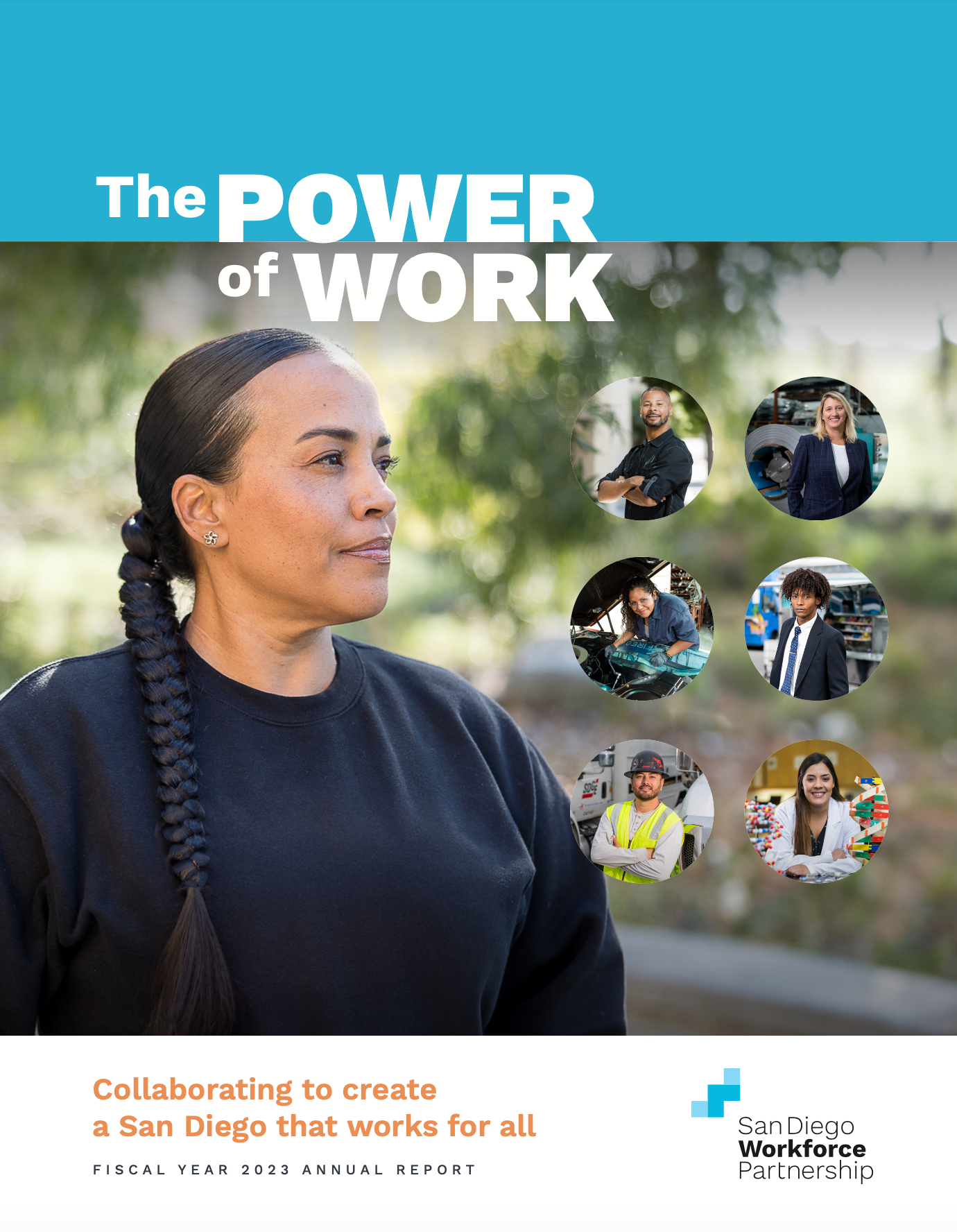Reports
Fiscal Year 2023 Annual Report
We are pleased to share our Fiscal Year 2023 Annual Report, highlighting collective efforts and selected services during July 1, 2022–June 30, 2023, framed by the organization’s core values—Collaboration, Excellence, Stewardship, Inclusion and Equity. Embracing workforce development requires understanding, meeting and anticipating the current and future needs of workers and employers alike. We continue to collaborate with partners, businesses, elected officials, donors and funders to address these needs by ensuring all job seekers, employers and students receive equal access to the skills and resources necessary for success. This report offers success stories of how we’re striving for a more equitable region, focusing funding and resources on those too often excluded from higher quality jobs and upward economic mobility. We look forward to continuing to build on this progress together in fiscal year 2024 and beyond.

Pathways for Immigrants
From 2019 to 2021 the San Diego Workforce Partnership and Walmart partnered in an innovative initiative to help upskill workers in retail and improve their English fluency, opening pathways for New Americans in customer-facing and management retail jobs. The program seemed well-designed to meet a significant need and initially, retail employers were excited to partner. Unfortunately, the COVID-19 pandemic and resulting disruption to retail operations and staffing required the Workforce Partnership to pivot and eventually close the program. Despite this setback, our experience with the Pathways for Immigrants program has generated valuable insights into the viability and likely impact of similar efforts in the future. This report describes the program, reviews its progress and challenges, and presents a logic model for future programs integrating the lessons learned from the Pathways for Immigrants Program.

San Diego Behavioral Health Workforce Report
San Diego County is facing a significant behavioral health (BH) worker shortage. This report estimates 17,000 BH professionals were employed in 11 key occupations in 2022. This is 8,000 workers short of the 25,000 needed.
Public investment in behavioral health services at the federal, state, and local level continue to increase. Services for crisis care, homelessness prevention, substance use prevention and treatment services, expanded services in public schools and healthcare integration are all driving more demand for BH workers. Demographic trends are not helping; each year more San Diego workers retire than the year before as the “baby-boom” generation ages. In 2018, for example, about half of California’s psychiatrists are over 60 years of age (UCSF).
The convergence of these demographic trends, the global pandemic, growing mental health and substance use crises and historic public spending focused on expanding BH services raises a fundamental question: Is our regional Behavioral Health Workforce equipped to meet the need?

Strategy Guidebook: Promoting Careers in Electric Mobility
The strategy guidebook, Promoting Careers in Electric Mobility, was created to empower educators and school administrators to share information about the growing industry and subsequent career pathways with students and families. Developed by the San Diego Workforce Partnership in collaboration with ENGIE Impact and Grossmont Union High School District (GUHSD), the guidebook outlines strategies to make career opportunities created by this movement toward electric vehicles (EV) more accessible, especially to students in disadvantaged and low-income communities.
Educators, school administrators and career counselors in K-12 schools can use this guide to support students in their career exploration. Along with providing resources created specifically for this project, the guide also includes suggested strategies for implementing the tools and a summary of industry and government partners who can introduce students and families to the possibility of a quality job in clean energy.

San Diego County Youth Disconnection in the Pandemic
Reducing youth disconnection and the barriers to economic opportunity is critically important to ensure the health of our communities and our economy. Reaching our youth at this critical point in their lives with support, services and hope is life-changing. Data on youth disconnection can help us understand the challenges young people face and is essential for designing and implementing interventions and opportunities that lead to meaningful change. In this report, we examine the latest data on youth disconnections during 2020, including the height of the COVID-19 pandemic, and the relationship to young San Diegans’ access to education and employment.

Expanding Access to Healthcare Jobs in San Diego County
This report is designed to shape the San Diego Workforce Partnership’s strategy for helping workers— especially women and people of color, and especially those without a college degree—find a pathway to the middle class in the healthcare sector. JP Morgan Chase provided funding for this reports and for two pilot programs that are shaped by this analysis. The first section provides an overview of San Diego County’s healthcare sector, its role in our economy, constituent industries and most common jobs. The second section assesses occupational segregation in healthcare and identifies the 11 most promising job options for our clients. The third section discusses how we can, through talent-pipeline management, expand this list to provide more pathways to the middle class.

Employer Attitudes Toward Hiring Justice-involved Workers
Employer attitudes toward justice-involved applicants play a strikingly important role not just for those applicants but for society. Employment is a key driver of desistance from crime, but many justice-involved individuals struggle to find stable employment, partly because they are discriminated against in the job market.
Improving employer attitudes toward justice-involved applicants would cause them to hire more such applicants facilitating desistance from crime, reducing incarceration spending, and improving public safety. This report explores this topic to inform our strategic plan for serving the employment needs of justice-involved individuals in San Diego and Imperial Counties.

The Need for Stable Scheduling in San Diego’s Service Sectors
Service-sector businesses and their workers can benefit from more predictable and stable work schedules. The San Diego Workforce Partnership is working with businesses to develop innovative scheduling strategies because we believe stable schedules serve the “double bottom line”—both increasing profits (primarily through savings on turnover and absenteeism) and increasing workers’ quality of life.

Essential Skills Rubrics
The Essential Skills Rubrics, created in partnership with the San Diego County Office of Education, align with the six essential skills—emotional intelligence, communication, creative & critical thinking, collaboration, dependability and resourcefulness. It is crucial to model, evaluate and set goals around essential skills to support career readiness, growth and advancement. Essential skills apply across all sectors and impact students at every phase of their learning and into a career.
Educators in K-12 schools, colleges and professional training programs can use these rubrics at any grade level, and career counselors can use them to promote self-awareness in job seekers.
For more tools, visit San Diego County Office of Education.

Race, Place and Opportunity: An Update on San Diego County’s Progress Toward Reducing Youth Disconnection
Addressing systemic inequality is more important now than ever as COVID-19 disproportionately impacts San Diegans who have long been excluded from opportunity. While we mount a full-scale response to the unprecedented layoffs caused by this pandemic, the Workforce Partnership is not losing sight of our long-term goals, including cutting the rate of youth disconnection and reducing the gaps in economic opportunity between communities. This is our fourth annual report sharing the latest available data on youth disconnection from the American Community Survey.

